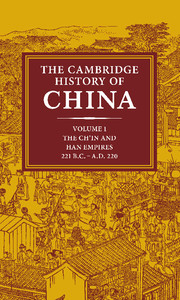Book contents
- Frontmatter
- Introduction
- 1 The state and empire of Ch'in
- 2 The Former Han dynasty
- 3 Wang Mang, the restoration of the Han dynasty, and Later Han
- 4 The conduct of government and the issues at stake A.D. 57–167
- 5 The fall of Han
- 6 Han foreign relations
- 7 The structure and practice of government
- 8 The institutions of Later Han
- 9 Ch'in and Han law
- 10 The economic and social history of Former Han
- 11 The economic and social history of Later Han
- 12 The religious and intellectual background
- 13 The concept of sovereignty
- 14 The development of the Confucian schools
- 15 Confucian, Legalist, and Taoist thought in Later Han
- 16 Philosophy and religion from Han to Sui
- Bibliography
- Glossary-Index
- Map 7 The Han empire, 143 b.c.
- Map 8 The Han empire, 108 b.c
- Map 9 The Han empire, a.d. 2
- Map 12 The Han empire, a.d. 140">
- References
7 - The structure and practice of government
Published online by Cambridge University Press: 28 March 2008
- Frontmatter
- Introduction
- 1 The state and empire of Ch'in
- 2 The Former Han dynasty
- 3 Wang Mang, the restoration of the Han dynasty, and Later Han
- 4 The conduct of government and the issues at stake A.D. 57–167
- 5 The fall of Han
- 6 Han foreign relations
- 7 The structure and practice of government
- 8 The institutions of Later Han
- 9 Ch'in and Han law
- 10 The economic and social history of Former Han
- 11 The economic and social history of Later Han
- 12 The religious and intellectual background
- 13 The concept of sovereignty
- 14 The development of the Confucian schools
- 15 Confucian, Legalist, and Taoist thought in Later Han
- 16 Philosophy and religion from Han to Sui
- Bibliography
- Glossary-Index
- Map 7 The Han empire, 143 b.c.
- Map 8 The Han empire, 108 b.c
- Map 9 The Han empire, a.d. 2
- Map 12 The Han empire, a.d. 140">
- References
Summary
THE CIVIL SERVICE
The system of imperial government evolved during the Ch'in and Han periods was marked by the division of responsibilities, the duplication of some offices, and the organization of civil servants into hierarchies. By these means it was hoped to avoid undue concentration of power in any particular individual and to attract a sufficient number of recruits to staff the agencies of the empire.
Several edicts reflect the need to find suitable men in sufficient numbers for the purpose. In theory it was open to all men to join the service, but at times restrictions were placed on merchants and shamans, and a minimum qualification of wealth was sometimes applied. In addition, a ban on holding office could sometimes be imposed as a punishment or as a means of preventing the growth of political coteries. For long the inhabitants of kingdoms were not entitled to take office in the central government for fear that they might use such opportunities to start disloyal or separatist movements in the capital city.
A career in the service allowed a man to rise from a humble position as a clerk to become a senior director of an office and thereafter a statesman responsible for framing policies and major decisions of state. One and the same man could thus be required during his career to implement the commands of his superiors, to propose policies for consideration, and to act as a judicial authority. Normally candidates for office were not expected to possess specialist skills, but there was an exception under Yüan-ti (r. 49–33 B.C.), who called for men versed in the understanding of yin and yang and their visitations, and it was not unknown for experts in mathematics or those experienced in industrial enterprises to rise speedily.
- Type
- Chapter
- Information
- The Cambridge History of China , pp. 463 - 490Publisher: Cambridge University PressPrint publication year: 1986
References
- 3
- Cited by

